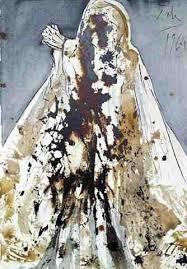Reflections on John 11:32-44, delivered at Our Lady of Guadalupe Episcopal Church.
*******
I would have stayed in the tomb.
In the Middle East, it’s hot. Which means decomposition sets in quick, and the stench of that rotting process is heavy in the air. So if I had been four days in a tomb, in the heat — essentially the tomb becomes a warmed oven — I think I would have been too ashamed to come out.
And on top of that, there’s the problem of the bindings. The text describes how “his hands and feet were bound with strips of cloth, and his face wrapped in a cloth.” In the burial customs of the time, strips of cloth were tightly wound around the body — they bound the jaw closed, the feet together, and the hands to the side of the body. Which means that even after the shock of finding himself alive in his tomb, Lazarus is faced with the problem of exiting the tomb. He cannot walk with his feet bound together. He cannot even crawl with his hands tied to his side. The text doesn’t describe what must have been Lazarus’s struggling exit from the tomb; we can only imagine the movements of rolling and shuffling and squirming that must have taken him from the darkness to the light.
I would have stayed in the tomb. It would be less painful to stay dead than to suffer the humiliation of exiting on my belly and the shame of exposing the community to the stench of my death.
And that’s not to mention life after the tomb. In a culture where the dead are considered unclean, untouchable — where does an undead person go? what does he do? who will be near him, eat with him, care for him?
In commanding “Lazarus, come out!” — rather than going in, gathering up Lazarus in his arms, and carrying him out like a fireman making a rescue — in commanding Lazarus to come out, Jesus is asking a lot of his beloved friend. Jesus asks for Lazarus’s struggle and his exposure. Jesus asks for him to risk living with social stigma. Jesus asks for his full participation.
I would have stayed in the tomb.
Unless, perhaps, it becomes too painful to stay in the tomb any longer. I think we all reach this point, in different ways, at various moments of our life.
Perhaps it’s physical — our body is in pain or we suffer an addiction, and we know we can no longer keep living the way we have been, that our lifestyle habits have become a kind of tomb that we must leave in order to have real life.
Perhaps it’s relational — something about the person I become when I’m with this other person has turned my home into a kind of tomb, has bound me up in some way that I no longer feel like I have agency, and I need to crawl to someone who can unbind me.
Perhaps it’s societal, living in a system that bends toward injustice and it even though it will be really difficult to get out, staying in the tomb, staying with the way things are, is just no longer an option.
Jesus did not prevent his friend from dying. Mary and the Jews have a point: If Jesus had been there, Lazarus would not have died. So it seems that Jesus did not come to rescue us from going through difficulties.
And on the other side of death, at the tomb, at this scene: Jesus does does not rush into the tomb to deliver Lazarus out like a fireman rushing into a building burning. Rather, Jesus invites Lazarus to participate in his own salvation. Having done what he could do in raising Lazarus to life, Jesus expects Lazarus to do what he could do by making his way out of the tomb.
It’s when each of us is in a place of death — of pain and suffering and stench and shame — it’s when we feel trapped and bound and unable to act — it’s in death that Jesus offers the possibility of new life. Jesus calls to us. He calls to us: Come out! He invites us: Come out! He offers us hope that there is new life waiting to be had. Come out!
Jesus looks at something dead and see it as full of potential for life. Jesus looks at a corpse in a dark tomb and invites a living body into the light. Jesus looks at his beloved one and shows that death does not have to be the end of the story.
Having done what he can do in inviting us to new life, Jesus expects us to do what we can do to in our own movement and struggle out of our tombs.
Come out! Come out!


